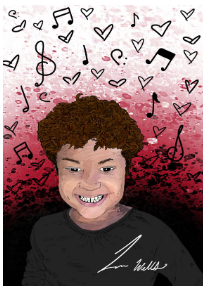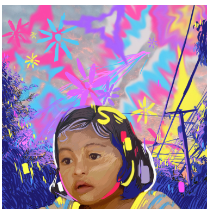Art II: Digital Media and Design students will develop and explore skills and techniques for problem-solving digital design tasks, such as 2-D and 3-D imaging and printing, restorative and altering digital images, graphic design, and integration into other art media. Using the artistic and design process, emphasis will include approaching the computer as a creative and practical tool using contemporary programs, media, and techniques. Imaging applications like Photoshop will be explored for fine art and design experiences. Students will understand how technology's history and function have dramatically changed how society creates and perceives the arts. Visual arts technology-based careers, such as animators, modelers, technicians, or art directors, will be explored through a historical and
contemporary lens. Students will build and maintain digital portfolios documenting their artistic growth throughout the course. Students will develop visual literacy and appreciation for art through written, visual and verbal expression. Students will also explore public art and copyright fundamentals in the field of digital art, as well as participate in various art shows.
Essential Questions: What Are the Big Issues About Art? How and Why Do We Make Art? How Does Art Relate to History and Culture? How Do We Respond to Works of Art? How do We Use New Media to Create Works of Art?
|
Unit Title and Quarter |
QUARTER 1 |
QUARTER 2 |
QUARTER 3 |
QUARTER 4 |
||
|
Artist’s as Technology Creators |
Cultural Identity to Build Community |
Diverse Perspectives and Digital Responsibility |
Real World Application and Connection |
|||
|
Image Cue |

|
 |

|

|
||
|
Focus of the Story |
We begin by starting our journey by discussing how people make art and use digital tools. We look to this as a foundation of the purpose of our journey in the art classroom developing ourselves as artists in the technology field. We use the creative process to start to utilize these tools to experiment with various new media forms. |
Once we understand the beginning steps, we can start to shift our focus on how art reflects our personal and shared identities through use of new media. We can look at our relationships with our community and cultural backgrounds to build the foundation on the importance of technology based art and its history. |
Now, we can move into understanding and developing an appreciation of the diverse values of others. Receiving and articulating ideas based on personal perspective and interpretation of ideas. We can look at the development of such new media tools to guide us to build our foundation of knowledge and share our learning with our community. |
Finally, we can explore how art allows us to transform our ideas and approaches and be innovative with our ideas. Allowing ourselves to take creative healthy risks through application of design. We can reflect on our background and share our stories with others to build upon ideas and grow as an art community. We can reflect on the use of technology arts to prepare us for career ready opportunities. |
||
|
Transfer Goals |
The Creative Process Apply creative process through inquiry, investigation, generating ideas, testing solutions, refining, and reflecting on process and product while developing a personalized portfolio exhibiting original voice and vision as an artist. Techniques & Application Able to transfer and apply knowledge of artistic skills and techniques when developing ideas for creative expression through a variety of media. |
Critical Thinking & Communication Understands and develops an appreciation that art can have diverse values, meanings, and definitions while recognizing multiple responses and perspectives. Effective at receiving and articulating ideas using appropriate vocabulary and communication when responding to works of art. Able to work independently and collaboratively. History/Culture/Citizenship: Explore and understand historical influences of art through the work of self and others while cultivating an awareness that art is a reflection of time, place and culture. Students identify and interact with art as a community member and citizen, developing a lifelong engagement with art as a supporter, advocate, creator, and informed viewer. |
Critical Thinking & Communication Understands and develops an appreciation that art can have diverse values, meanings, and definitions while recognizing multiple responses and perspectives. Effective at receiving and articulating ideas using appropriate vocabulary and communication when responding to works of art. Able to work independently and collaboratively. History/Culture/Citizenship: Explore and understand historical influences of art through the work of self and others while cultivating an awareness that art is a reflection of time, place and culture. Students identify and interact with art as a community member and citizen, developing a lifelong engagement with art as a supporter, advocate, |
Techniques & Application Able to transfer and apply knowledge of artistic skills and techniques when developing ideas for creative expression through a variety of media. Innovation in the Arts Understands and applies the artistic process, problem-solving skills, current and emerging technologies while making connections to visual arts careers. |
||
|
Learning Targets |
As an artist, I can: Apply creative thinking to digital original artistic works and generate ideas for works of art through exploration and inquiry. Select programs, media, and processes of personal interest and communicate a personal style and point of view in artwork. Identify and apply a creative process to develop ideas and digital artwork and refine and edit original works of art, Communicate and express an idea, and expand the use of a digital process art portfolio to include research, inquiry, preliminary sketches, completed works, critical writings, and reflections and select, prepare, and submit works of art for exhibition. |
As an artist, I can: Analyze, interpret, and evaluate digital artwork and communicate well-supported and persuasive interpretations of still and/or moving digital media using appropriate terminology Identify common characteristics of works of art and design that are presented as a series or sequence and describe, analyze, interpret, and evaluate personal, peer, and professional works of art and design expand on constructive approaches to critique such as in-progress (formative), self-reflective, and summative. Identify ways digital art can be used to address community needs. |
As an artist I can: Understand digitally diverse historical and cultural influences of art and identify diverse historical and contemporary artists and artworks including the value, roles, and reasons for creating art from various perspectives Examine and discuss social, political, economic, and cultural factors that influence works of art and design and investigate how art and design can be viewed from a variety of personal, cultural, and historical perspectives. Demonstrate personal responsibility for the care and safe use of shared spaces and art equipment: and apply communication and collaboration skills in the digital art studio. |
As an artist, I can: Describe various digital art-related skills that connect to postsecondary educational and career opportunities and demonstrate innovative thinking in the design process: Identify the ways in which art-related skills are used in various industries and generate creative solutions by utilizing the design process, and collaborate with a team to produce a final design for a client. Identify how digital media and technology tools can be used to create, edit and present works of digital art and explore new technology media, tools and techniques for the production of art and use new technology in the development or production of an artwork. Interpret a subject and apply knowledge of digital art/design history to the development of their personal style. |
||
